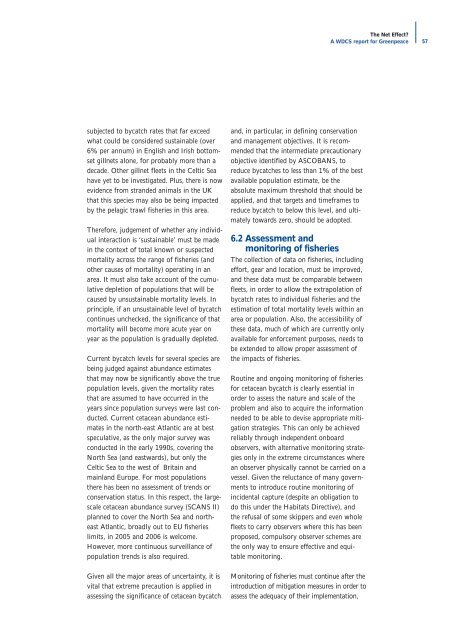The Net Effect? - Whale and Dolphin Conservation Society
The Net Effect? - Whale and Dolphin Conservation Society
The Net Effect? - Whale and Dolphin Conservation Society
You also want an ePaper? Increase the reach of your titles
YUMPU automatically turns print PDFs into web optimized ePapers that Google loves.
subjected to bycatch rates that far exceed<br />
what could be considered sustainable (over<br />
6% per annum) in English <strong>and</strong> Irish bottomset<br />
gillnets alone, for probably more than a<br />
decade. Other gillnet fleets in the Celtic Sea<br />
have yet to be investigated. Plus, there is now<br />
evidence from str<strong>and</strong>ed animals in the UK<br />
that this species may also be being impacted<br />
by the pelagic trawl fisheries in this area.<br />
<strong>The</strong>refore, judgement of whether any individual<br />
interaction is ‘sustainable’ must be made<br />
in the context of total known or suspected<br />
mortality across the range of fisheries (<strong>and</strong><br />
other causes of mortality) operating in an<br />
area. It must also take account of the cumulative<br />
depletion of populations that will be<br />
caused by unsustainable mortality levels. In<br />
principle, if an unsustainable level of bycatch<br />
continues unchecked, the significance of that<br />
mortality will become more acute year on<br />
year as the population is gradually depleted.<br />
Current bycatch levels for several species are<br />
being judged against abundance estimates<br />
that may now be significantly above the true<br />
population levels, given the mortality rates<br />
that are assumed to have occurred in the<br />
years since population surveys were last conducted.<br />
Current cetacean abundance estimates<br />
in the north-east Atlantic are at best<br />
speculative, as the only major survey was<br />
conducted in the early 1990s, covering the<br />
North Sea (<strong>and</strong> eastwards), but only the<br />
Celtic Sea to the west of Britain <strong>and</strong><br />
mainl<strong>and</strong> Europe. For most populations<br />
there has been no assessment of trends or<br />
conservation status. In this respect, the largescale<br />
cetacean abundance survey (SCANS II)<br />
planned to cover the North Sea <strong>and</strong> northeast<br />
Atlantic, broadly out to EU fisheries<br />
limits, in 2005 <strong>and</strong> 2006 is welcome.<br />
However, more continuous surveillance of<br />
population trends is also required.<br />
Given all the major areas of uncertainty, it is<br />
vital that extreme precaution is applied in<br />
assessing the significance of cetacean bycatch<br />
<strong>and</strong>, in particular, in defining conservation<br />
<strong>and</strong> management objectives. It is recommended<br />
that the intermediate precautionary<br />
objective identified by ASCOBANS, to<br />
reduce bycatches to less than 1% of the best<br />
available population estimate, be the<br />
absolute maximum threshold that should be<br />
applied, <strong>and</strong> that targets <strong>and</strong> timeframes to<br />
reduce bycatch to below this level, <strong>and</strong> ultimately<br />
towards zero, should be adopted.<br />
6.2 Assessment <strong>and</strong><br />
monitoring of fisheries<br />
<strong>The</strong> collection of data on fisheries, including<br />
effort, gear <strong>and</strong> location, must be improved,<br />
<strong>and</strong> these data must be comparable between<br />
fleets, in order to allow the extrapolation of<br />
bycatch rates to individual fisheries <strong>and</strong> the<br />
estimation of total mortality levels within an<br />
area or population. Also, the accessibility of<br />
these data, much of which are currently only<br />
available for enforcement purposes, needs to<br />
be extended to allow proper assessment of<br />
the impacts of fisheries.<br />
Routine <strong>and</strong> ongoing monitoring of fisheries<br />
for cetacean bycatch is clearly essential in<br />
order to assess the nature <strong>and</strong> scale of the<br />
problem <strong>and</strong> also to acquire the information<br />
needed to be able to devise appropriate mitigation<br />
strategies. This can only be achieved<br />
reliably through independent onboard<br />
observers, with alternative monitoring strategies<br />
only in the extreme circumstances where<br />
an observer physically cannot be carried on a<br />
vessel. Given the reluctance of many governments<br />
to introduce routine monitoring of<br />
incidental capture (despite an obligation to<br />
do this under the Habitats Directive), <strong>and</strong><br />
the refusal of some skippers <strong>and</strong> even whole<br />
fleets to carry observers where this has been<br />
proposed, compulsory observer schemes are<br />
the only way to ensure effective <strong>and</strong> equitable<br />
monitoring.<br />
Monitoring of fisheries must continue after the<br />
introduction of mitigation measures in order to<br />
assess the adequacy of their implementation,<br />
<strong>The</strong> <strong>Net</strong> <strong>Effect</strong>?<br />
A WDCS report for Greenpeace<br />
57

















